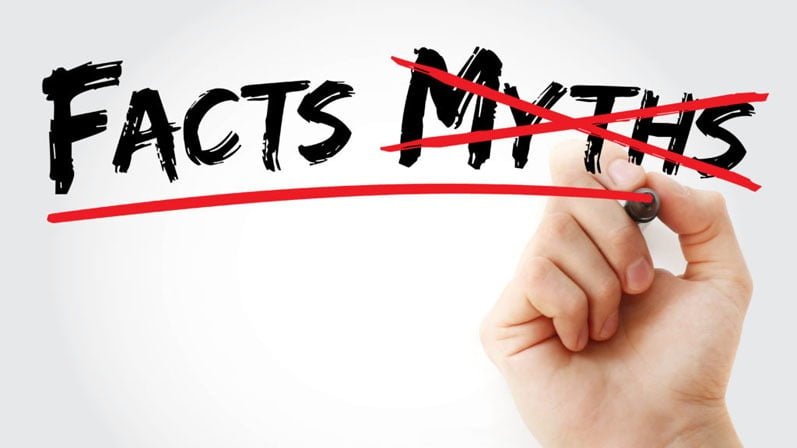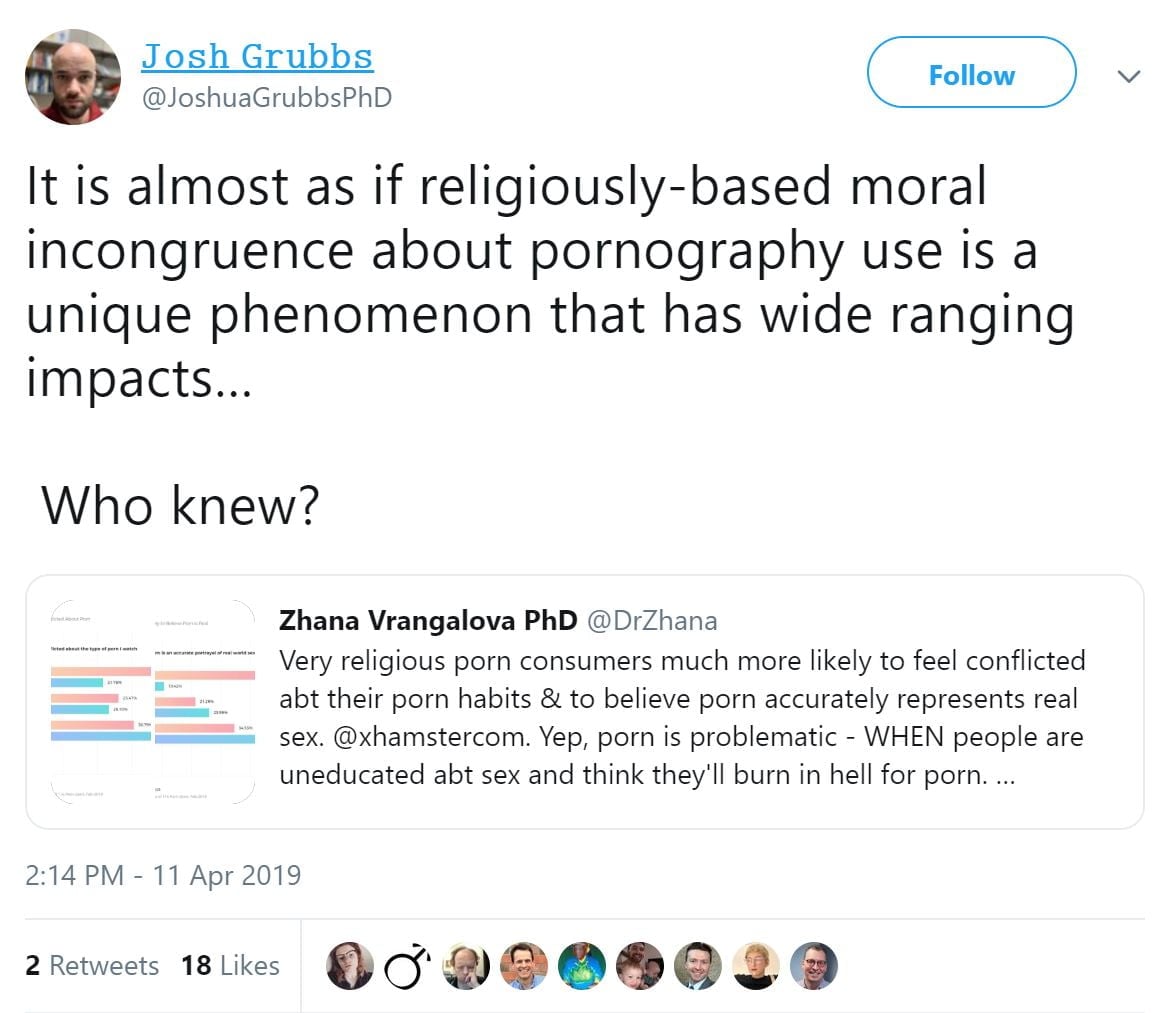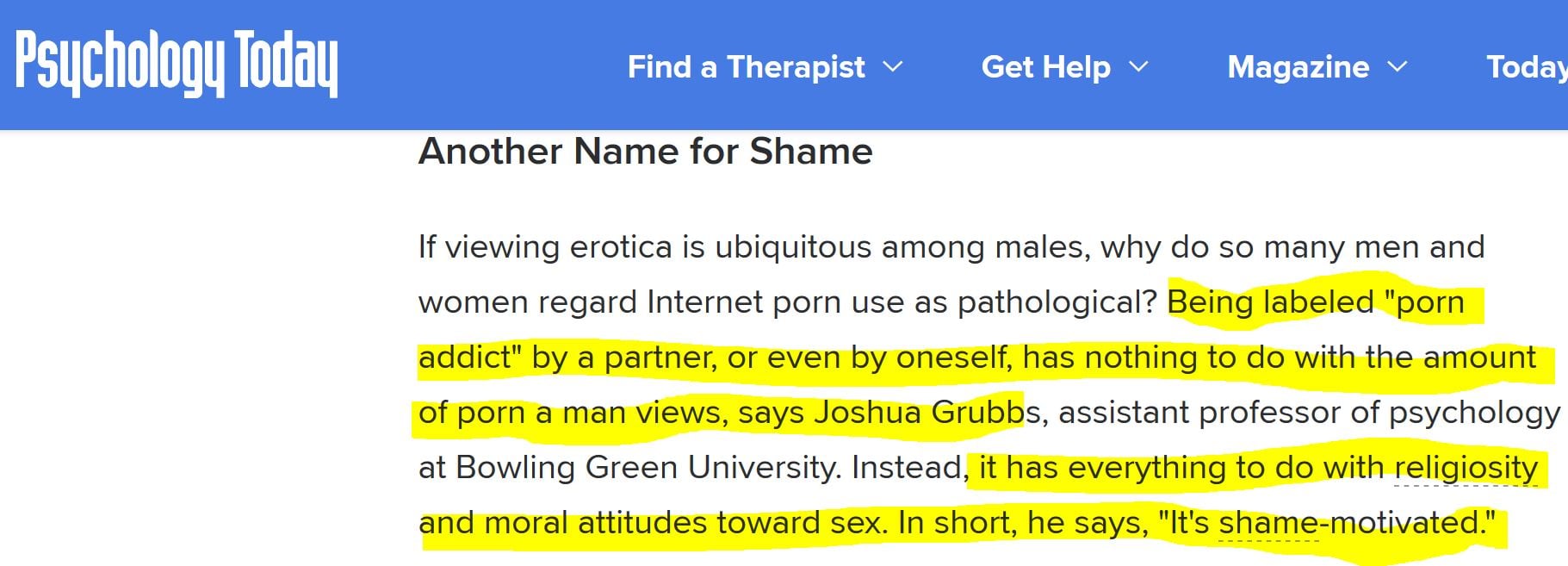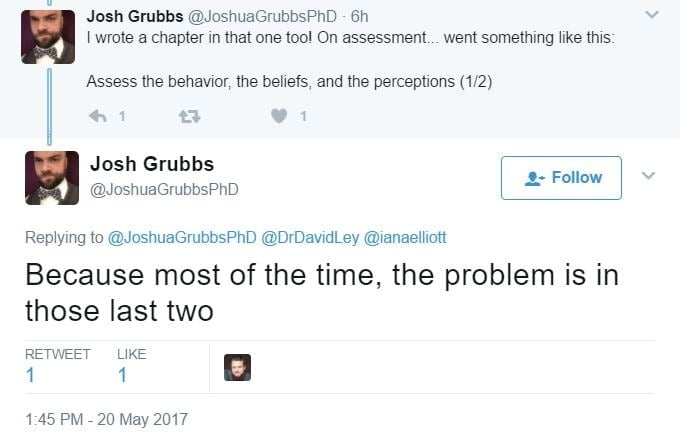Some of the world’s top behavioral addiction experts have just published a new study “Frequency of use, moral incongruence, and religiosity and their relationships with self‐perceived addiction to pornography, internet use, social networking and online gaming.” Don’t let its long-winded academic title fool you. It powerfully shatters one of the most pernicious myths that pro-porn researchers have hatched and fostered for much of the last decade.
This new study found that behavioral addicts (not just porn addicts) often disapprove of the behaviors they are struggling to eliminate. If that sounds like common sense, it is. But that didn’t stop a group of researchers from using evidence of porn addicts’ natural disapproval to create a powerful, flawed meme that porn problems are likely just due to religious shame or moral disapproval (and thus, by implication, that porn addiction isn’t real). Here’s the man behind the myth, Josh Grubbs, pushing his agenda:
What Grubbs and his colleagues forgot to investigate is whether other behavioral addicts also experience moral disapproval toward the activity they’re trying to eliminate. Their promotion of their MI model without first investigating that underlying assumption reveals either sloppiness or casts doubt on their scientific objectivity. Unfortunately, there’s substantial evidence of the latter.
Bowling Green State University’s Josh Grubbs (ably assisted by UCLA’s Rory Reid and multiple other colleagues) has been extremely vocal in the press and in the peer-reviewed literature – always discounting porn addiction and various porn-induced symptoms. And always implying that moral disapproval (and before that “perceived addiction”) explained more than any other factor related to compulsive porn use.
For example, Grubbs sums up his views in this extraordinary 2016 Psychology Today article, claiming that porn addiction is nothing more than religious shame, and not related to levels of porn use (a blatant lie).
These researchers orchestrated this “moral disapproval” campaign despite repeated findings in their own papers that porn addiction actually correlated most strongly not with disapproval but with levels of porn use! The latter findings point to porn addiction being real. Yet these researchers repeatedly swept these inconvenient findings under the rug.
Instead they ran with headlines, cover stories, and media quotations that emphasized only the weaker “disapproval” findings. The porn industry was only too happy to help publicize their misleading claims. (Note – Grubbs and 2nd author Sam Perry confirmed their agenda-driven bias when both formally joined allies Nicole Prause and David Ley as proud members of illegal trademark-infringing site “RealYourBrainOnPorn.com”).
Happily, in this case, science has finally self-corrected (the way it’s supposed to). “Moral disapproval” is not unique to porn addicts. All behavioral addicts experience “moral disapproval.” Thus, it’s finally evident that Grubbs et al built their campaign on a house of cards. The upshot is that all of the MI findings to date are worthy of an uninterested yawn – not the noisy, deceptive headlines they have received.
In the meantime, much damage has been done. These researchers’ misleading meme has persuaded many of their sexology and psychology colleagues that porn addiction is a doubtful concept. Those duped have ignored or simply discounted the vast evidence suggesting that porn addiction is as real as gambling and gaming addiction (both now codified in widely used diagnostic manuals).
Sadly, the baseless “MI = porn addiction” meme will continue to lurch around for a while, even though its head has been cut off. Look carefully at those who do research purporting to support the MI concept. Check for bias. (I offer an example later in this article.)
Background
To grasp the full significance of this new study you need some background.
As stated above, the “moral incongruence” (MI) model of explaining away porn addiction was the brainchild of pro-porn researcher Josh Grubbs. But MI was actually his second-generation anti-porn addiction meme.
Years earlier, Grubbs birthed and nurtured MI’s ill-fated precursor (“perceived addiction”) using his CPUI-9, a porn questionnaire skewed to cause religious porn users to score higher. Here’s my Twitter thread (and my longer article) explaining how all CPUI-9 studies produce biased results.
Essentially, the CPUI-9 questionnaire, while claiming to measure “perceived porn addiction,” did not stick to addiction-related questions, let alone have the power to distinguish “perceived” from “actual” addiction. However, many presumed it did, relying on its wholly inaccurate spin-term label “perceived addiction.” (The phrase “perceived pornography addiction” indicates nothing more than the total CPUI-9 score.)
The CPUI-9 cunningly included three extraneous questions about guilt and shame on which religious users would always score higher, thus guaranteeing skewed results that permitted a circular finding to Grubbs’s liking: being religious correlating with “perceived porn addiction.”
Here’s Grubbs’s dubious CPUI-9:
Perceived Compulsivity Section
- I believe I am addicted to Internet pornography.
- I feel unable to stop my use of online pornography.
- Even when I do not want to view pornography online, I feel drawn to it
Access Efforts Section
- At times, I try to arrange my schedule so that I will be able to be alone in order to view pornography.
- I have refused to go out with friends or attend certain social functions to have the opportunity to view pornography.
- I have put off important priorities to view pornography.
Emotional Distress Section (questions skewing results)
- I feel ashamed after viewing pornography online.
- I feel depressed after viewing pornography online.
- I feel sick after viewing pornography online.
As you can see, the CPUI-9 cannot distinguish between actual porn addiction and “belief” in porn addiction. Subjects never “labeled themselves as porn addicts” in any Grubbs CPUI-9 study. They simply answered the 9 questions above, and earned a total score.
Here’s the key to all the dubious claims and questionable correlations: the Emotional Distress questions (7-9) cause religious porn users to score higher, and secular porn users to score lower, as well as creating a strong correlation between “moral disapproval” and total CPUI-9 score (“perceived porn addiction”).
In short, correlations from Grubbs’s most famous study reveal that questions 7-9 skew everything towards his agenda of attempting to blame porn addiction on morals and religion:

To put it another way, if you use only results from CPUI-9 questions 1-6 (which assess the signs and symptoms of an actual addiction), the correlations dramatically change – and all the dubious articles claiming shame is the “real” cause porn addiction would never have been written. Such claims rest entirely on the manipulative Emotional Distress questions (7-9), which have no place in an assessment test for any addiction. Correlations from the same study reveal that levels of porn use are by far the best predictor of actual addiction (questions 1-6).

As long as no one looked under the hood, Grubbs’s meme that “porn addiction was just guilt and shame” was superficially supported. The media ran with it and Grubbs fanned the flames, as documented in this longer article.
Eventually researchers, including Grubbs himself (once he was under fire), began to test subjects more directly by asking porn users (1) whether they thought they were addicted, and (2) how religious they were. To Grubbs’s chagrin, there was no meaningful correlation. The “perceived addiction” myth was discredited, and even Grubbs abandoned it.
Undaunted by being called out for a flawed model with a misleading label (“perceived addiction”), in 2018, Grubbs et al launched the flawed “moral incongruence” or MI model. Taking up where “perceived addiction” left off, “moral incongruence” attempted to explain away porn addiction as a moral issue.
Grubbs et al and their followers swiftly pumped out studies and a review (!) correlating moral disapproval of subjects’ porn use with subjects’ porn addiction scores to support their shiny new meme. Grubbs tweets that porn problems are rarely actual addiction, just “beliefs” and “perceptions” (Grubbs is not a neuroscientist):
Alas, as stated earlier, he and his colleagues did so without first checking their underlying assumption (now shown to be incorrect) that porn use was somehow unique with respect to MI. They also largely buried their inconvenient findings that there was a much stronger correlation between levels of porn use and perception of oneself as an addict (which is what one would expect in addicts) than the correlation between MI and perception of oneself as an addict. Disturbing omissions, and two more strikes against Grubbs.
With the MI model now exposed as a red herring, and the CPUI-9 questionnaire revealed as irretrievably skewed, it’s time for study authors in this field to cease obscuring that the strongest correlations they obtain in their MI/CPUI-9 studies are between porn addiction and porn use – not between porn addiction and religion or MI. Their results are consistent with porn addiction. Period.
The MI campaign hits a wall
Here are some of the actual findings from the new study, which gut the MI model.
- Frequency of porn use was by far the strongest of the analyzed predictors (consistent with addiction).
- MI correlated with compulsive porn use, compulsive internet use, compulsive social networking and gaming – all to a similar degree.
- There was an insignificant correlation between compulsive porn use and religiosity. So, no support for Grubbs et al’s cherished meme that religious shame explains porn addiction.
Here are some excerpts:
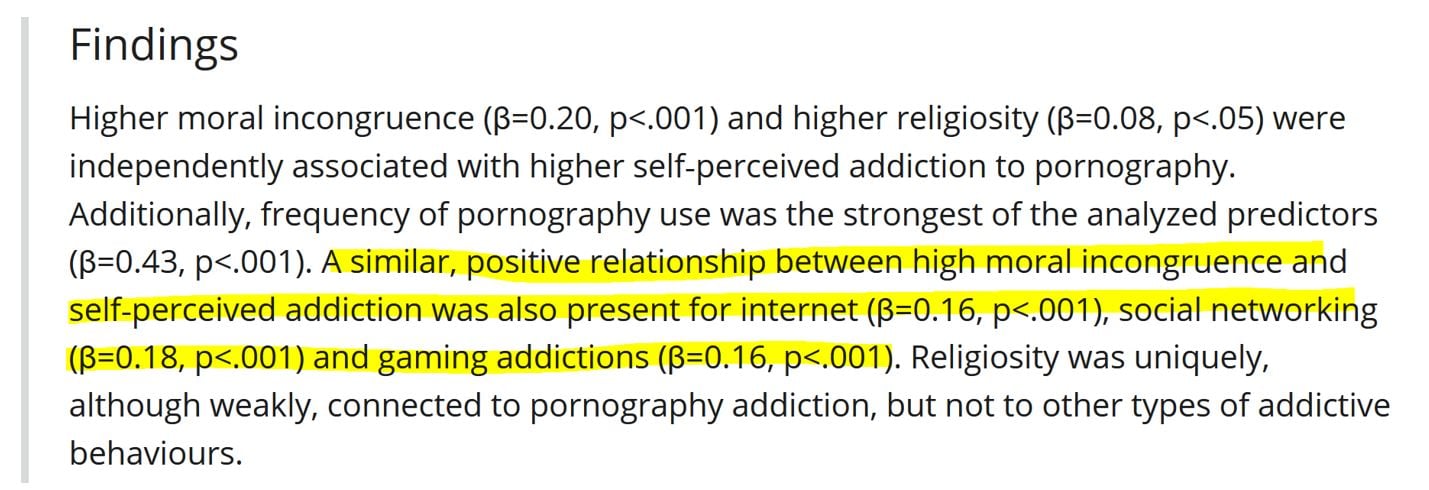
In short, individuals who are unable to control a behavior despite negative consequences, score somewhat higher on moral disapproval of the behavior (MI). And this study (and others) find that it’s not MI but higher levels of porn use that best predict porn addiction, by far. As for religion “causing” porn addiction, that too was debunked. In the table below frequency of porn use is robustly correlated with pornography addiction (0.42), yet has little correlation with religiosity (0.03).
Beware of sexologists still pushing the discredited MI model
As mentioned above, the “moral incongruence” meme-campaign has momentum that will carry it forward for some time. Many academics who peer-review articles will no doubt remain in their ill-informed, pro-porn sexology bubble. They may rubber-stamp results they like, unaware of the new research that shows the MI model always rested on a house of cards (now collapsed). The porn industry will continue to trumpet such results to protect its profits.
As an example, consider this new study in which a team of sexology researchers tried very hard to link MI with “shame-proneness” as a way of convincing people that shame causes people to perceive themselves as addicted (or “dysregulated” as these anti-addiction researchers label compulsive use). Their hypothesis failed, and one can almost hear lead author Brian A. Droubay (anti-porn addiction proponent) gnashing his teeth.
In this study, MI correlated with “feelings of dysregulated porn use” (as it does in all behavioral addictions). But the “shame-proneness” correlation was insignificant. Maybe Droubay should spend some time on the online recovery forums reading what users actually report instead of trusting to his outdated assumptions about religious shaming.
If Droubay himself was shamed about his sexuality that is extremely unfortunate. But if he is ex-religious or anti-“morality,” like many pro-porn academics, perhaps he should recuse himself from the debate. It may be clouding his perception and ability to design impartial research, as it has for some of his most vocal fellow sexologists.
Droubay and colleagues’ introduction is a hymn of praise to the work of some of the most pro-porn authors (Prause, Ley, Walton, Reid, Cantor and Grubbs and colleagues), ignoring much of the research that runs counter to their preferred narrative. Astonishingly, they don’t even fully acknowledge that “Compulsive Sexual Behaviour Disorder” (the new diagnosis in the ICD-11 diagnostic manual adopted last year by the World Health Organization) definitely encompasses compulsive porn use!
Instead they try to persuade the reader that desire to masturbate (presumably to porn) is just evidence of high sexual desire – even though high desire may also indicate addictive cravings. Incidentally, these researchers never mention that multiple studies have distinguished dysregulated use from actual sexual desire. The two are not the same, but pro-porn sexologists consistently pretend that these concepts are interchangeable.
Tellingly, the authors gathered, but didn’t report, the correlation between frequency of porn viewing and feeling dysregulated. My guess is that it would have been stronger than the MI correlation they wanted to emphasize. Instead they excluded frequency of porn viewing and argued that, in any case, frequency would best be viewed as…you guessed it…a measure of “solitary sexual desire” than a measure of dysregulation.
Conclusion
The amount of damage done and misinformation spread via the “moral incongruence model” myth is incalculable. The public has been gravely misled about the source of porn addicts’ distress. Atheist and agnostic porn users may erroneously believe they are safe from porn addiction because they have no moral scruples about its use. And worst of all many healthcare providers have been deceived. They’ve fallen for the myth that porn addiction isn’t real and thus can’t be diagnosed, so they don’t bother assessing for it properly using existing assessments.
It’s time to stamp out the myth that MI tells us anything useful about porn-induced problems, so that it and its progeny stop distorting the field of porn addiction research. Porn addiction is every bit as real and risky as gaming and gambling addiction. It has never been reducible to “shame” no matter how skillfully any agenda-driven research is executed or sold to the public.
The MI myth was never anything more than propaganda. Time to let it go.
Formal criticisms (by researchers) of “Pornography Problems Due to Moral Incongruence: An Integrative Model with a Systematic Review and Meta-Analysis” (2018):
- Dysregulated Pornography Use and the Possibility of a Unipathway Approach (2018), by Paul J. Wright
- Stuck in the Porn Box (2018), by Brian J. Willoughby
- Hitting the Target: Considerations for Differential Diagnosis When Treating Individuals for Problematic Use of Pornography (2018), by Shane W. Kraus & Patricia J. Sweeney
- Theoretical Assumptions on Pornography Problems Due to Moral Incongruence and Mechanisms of Addictive or Compulsive Use of Pornography: Are the Two “Conditions” as Theoretically Distinct as Suggested? (2018) by Matthias Brand, Stephanie Antons, Elisa Wegmann, Marc N. Potenza
- What should be included in the criteria for compulsive sexual behavior disorder? (2020): The “Moral Incongruence” section.
Finally, here is Grubbs’s self-serving, rather desperate attempt to breathe life back into the corpse of his “Moral Incongruence” model. It can be summarized as his attempt to keep “moral incongruence” in play, despite it not performing well as a theory. Why not just find a theory that fits the facts?
